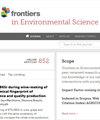Supply chain carbon abatement under different power structures: impact of consumers’ low-carbon preference and carbon tax policy
IF 3.3
3区 环境科学与生态学
Q2 ENVIRONMENTAL SCIENCES
引用次数: 0
Abstract
Supply chain carbon abatement is an important way to promote low-carbon transformation of the social economy and address global climate change. This paper analyzes the issue of supply chain carbon abatement under different power structures, as well as the effect of consumers’ low-carbon preference and carbon tax rate on the optimal decisions. This paper constructs five different models, namely ML-NO model, ML-CS model, RL-NO model, RL-CS model and VI model. The research finds that VI model is the most ideal model for promoting supply chain carbon abatement. The optimal abatement efforts, market demand, and total profits in the VI model are all the largest among the five models. Whether the supply chain leader is the manufacturer or the retailer, cost sharing contract can enhance optimal abatement efforts, market demand, and profits of both parties. In any model, the leader in Supply chain earns higher profits than the follower. When consumers’ low-carbon preference increases, the optimal abatement efforts, market demand, and profits of both parties will all increase, and the growth rate is gradually accelerating. For the manufacturer with high carbon emissions, when the carbon tax rate increases, the optimal abatement efforts first increase and then decrease. For the manufacturer with low carbon emissions, when the carbon tax rate increases, the optimal abatement efforts will also increase.不同权力结构下的供应链碳减排:消费者低碳偏好和碳税政策的影响
供应链碳减排是促进社会经济低碳转型、应对全球气候变化的重要途径。本文分析了不同权力结构下的供应链碳减排问题,以及消费者低碳偏好和碳税率对最优决策的影响。本文构建了五个不同的模型,即 ML-NO 模型、ML-CS 模型、RL-NO 模型、RL-CS 模型和 VI 模型。研究发现,VI 模型是促进供应链碳减排的最理想模型。在五种模型中,VI 模型的最优减排力度、市场需求和总利润都是最大的。无论供应链领导者是制造商还是零售商,成本分摊合同都能提高双方的最优减排量、市场需求和利润。在任何模型中,供应链领导者都比跟随者获得更高的利润。当消费者的低碳偏好增加时,双方的最优减排努力、市场需求和利润都会增加,且增长速度逐渐加快。对于高碳排放制造商,当碳税率增加时,最优减排努力先增加后减少。对于低碳排放的制造商,当碳税率增加时,最佳减排努力也会增加。
本文章由计算机程序翻译,如有差异,请以英文原文为准。
求助全文
约1分钟内获得全文
求助全文
来源期刊

Frontiers in Environmental Science
Environmental Science-General Environmental Science
CiteScore
4.50
自引率
8.70%
发文量
2276
审稿时长
12 weeks
期刊介绍:
Our natural world is experiencing a state of rapid change unprecedented in the presence of humans. The changes affect virtually all physical, chemical and biological systems on Earth. The interaction of these systems leads to tipping points, feedbacks and amplification of effects. In virtually all cases, the causes of environmental change can be traced to human activity through either direct interventions as a consequence of pollution, or through global warming from greenhouse case emissions. Well-formulated and internationally-relevant policies to mitigate the change, or adapt to the consequences, that will ensure our ability to thrive in the coming decades are badly needed. Without proper understanding of the processes involved, and deep understanding of the likely impacts of bad decisions or inaction, the security of food, water and energy is a risk. Left unchecked shortages of these basic commodities will lead to migration, global geopolitical tension and conflict. This represents the major challenge of our time. We are the first generation to appreciate the problem and we will be judged in future by our ability to determine and take the action necessary. Appropriate knowledge of the condition of our natural world, appreciation of the changes occurring, and predictions of how the future will develop are requisite to the definition and implementation of solutions.
Frontiers in Environmental Science publishes research at the cutting edge of knowledge of our natural world and its various intersections with society. It bridges between the identification and measurement of change, comprehension of the processes responsible, and the measures needed to reduce their impact. Its aim is to assist the formulation of policies, by offering sound scientific evidence on environmental science, that will lead to a more inhabitable and sustainable world for the generations to come.
 求助内容:
求助内容: 应助结果提醒方式:
应助结果提醒方式:


